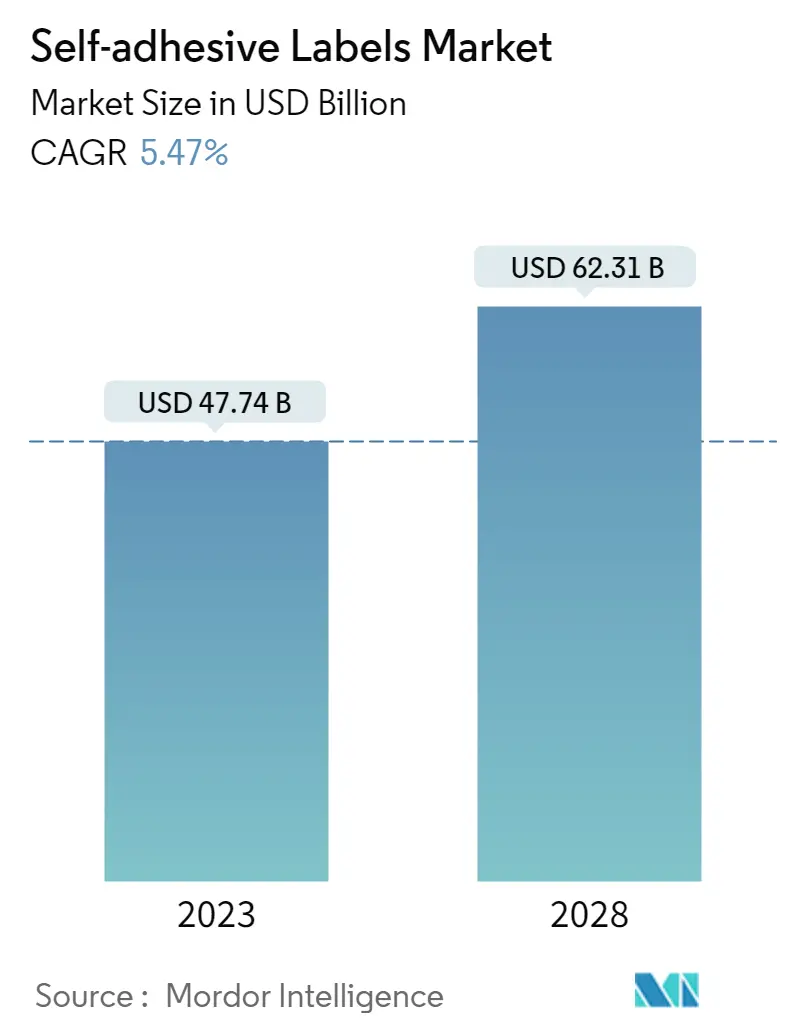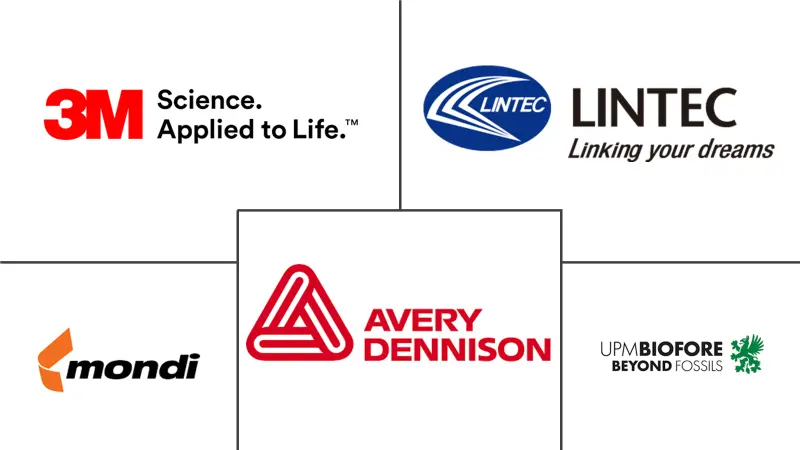Market Size of Self-adhesive Labels Industry

| Study Period | 2019 - 2029 |
| Market Size (2024) | USD 50.35 Billion |
| Market Size (2029) | USD 65.72 Billion |
| CAGR (2024 - 2029) | 5.47 % |
| Fastest Growing Market | Asia Pacific |
| Largest Market | Asia Pacific |
| Market Concentration | Low |
Major Players
*Disclaimer: Major Players sorted in no particular order |
Self Adhesive Labels Market Analysis
The Self-adhesive Labels Market size is estimated at USD 50.35 billion in 2024, and is expected to reach USD 65.72 billion by 2029, growing at a CAGR of 5.47% during the forecast period (2024-2029).
The COVID-19 outbreak and the subsequent nationwide lockdowns, disruption in manufacturing activities and supply chains, and production halts negatively impacted the market in 2020. However, the conditions started recovering in 2021, restoring the market's growth trajectory for the forecast period.
- The rapidly growing e-commerce industry and increased consumption of food and beverage products will likely drive the market demand.
- Conversely, increasing government regulations and the availability of substitutes like linerless labels will likely hinder market growth.
- The increasing demand for bio-based self-adhesives with a shift to sustainable practices will act as an opportunity for the market studied.
- Asia-Pacific dominated the market with a significant share and is expected to continue its dominance during the forecast period.
Self Adhesive Labels Industry Segmentation
Self-adhesive labels are special labels that contain a surface with an adhesive and generally do not require glue or moisture to stick in. A self-adhesive label can be used on any material, as they require pressure to create a bond between the adhesive and the product. These labels do not require water, solvent, or heat to adhere to the product. The self-adhesive labels market is segmented by adhesive type, face material, application, and geography. The market is segmented by adhesive type into hot melt, emulsion acrylic, and solvent. By face material, the market is segmented into paper and plastic. The market is segmented by application into food and beverage, pharmaceutical, logistics and transport, personal care, consumer durables, and other applications. The report also covers the market size and forecasts for self-adhesive labels in 15 countries across major regions. Market sizing and forecasts for each segment are based on revenue (in USD).
| Adhesive Type | |
| Hot-melt | |
| Emulsion Acrylic | |
| Solvent |
| Face Material | ||||||
| Paper | ||||||
|
| Application | |
| Food and Beverage | |
| Pharmaceutical | |
| Logistics and Transport | |
| Personal Care | |
| Consumer Durables | |
| Other Applications |
| Geography | |||||||
| |||||||
| |||||||
| |||||||
| |||||||
|
Self-adhesive Labels Market Size Summary
The self-adhesive labels market is poised for significant growth, driven by the expanding e-commerce sector and the increasing demand for food and beverage products. These labels play a crucial role in enhancing the aesthetic appeal of packaging, which is vital for attracting consumer attention and facilitating product sales. They provide essential information such as ingredient details, product identification, and usage instructions, particularly in the food and beverage industry. However, the market faces challenges from stringent government regulations and the availability of alternatives like linerless labels. Despite these challenges, the shift towards bio-based self-adhesives and sustainable practices presents a promising opportunity for market expansion. The Asia-Pacific region currently leads the market, with countries like China, India, Japan, and South Korea contributing significantly to the demand due to their burgeoning packaging, electronics, and personal care industries.
The market's growth trajectory is further supported by the robust development of the global food packaging market, which is expected to drive the demand for self-adhesive labels. The increasing investment in food processing and packaging industries, particularly in India, underscores the market's potential. Additionally, the rise in disposable incomes and the growing middle-class population in Asia-Pacific are expected to boost the demand for electronic products, thereby increasing the need for self-adhesive labels in electronics packaging. The pharmaceutical sector in India also presents a significant opportunity, with the country being a major supplier of pharmaceutical products globally. The market is characterized by fragmentation, with key players like 3M, Avery Dennison Corporation, UPM, Mondi, and LINTEC Corporation actively participating in strategic initiatives to strengthen their market positions and expand their product offerings.
Self-adhesive Labels Market Size - Table of Contents
-
1. MARKET DYNAMICS
-
1.1 Drivers
-
1.1.1 Rapidly Growing E-commerce Industry
-
1.1.2 Increasing Demand for Packed Foods from Food and Beverage Industry
-
1.1.3 Other Drivers
-
-
1.2 Restraints
-
1.2.1 Increasing Government Regulations
-
1.2.2 Other Restraints
-
-
1.3 Industry Value Chain Analysis
-
1.4 Porter's Five Forces Analysis
-
1.4.1 Bargaining Power of Suppliers
-
1.4.2 Bargaining Power of Consumers
-
1.4.3 Threat of New Entrants
-
1.4.4 Threat of Substitute Products and Services
-
1.4.5 Degree of Competition
-
-
-
2. MARKET SEGMENTATION (Market Size in Value)
-
2.1 Adhesive Type
-
2.1.1 Hot-melt
-
2.1.2 Emulsion Acrylic
-
2.1.3 Solvent
-
-
2.2 Face Material
-
2.2.1 Paper
-
2.2.2 Plastic
-
2.2.2.1 Polypropylene
-
2.2.2.2 Polyester
-
2.2.2.3 Vinyl
-
2.2.2.4 Other Plastics
-
-
-
2.3 Application
-
2.3.1 Food and Beverage
-
2.3.2 Pharmaceutical
-
2.3.3 Logistics and Transport
-
2.3.4 Personal Care
-
2.3.5 Consumer Durables
-
2.3.6 Other Applications
-
-
2.4 Geography
-
2.4.1 Asia-Pacific
-
2.4.1.1 China
-
2.4.1.2 India
-
2.4.1.3 Japan
-
2.4.1.4 South Korea
-
2.4.1.5 Rest of Asia-Pacific
-
-
2.4.2 North America
-
2.4.2.1 United States
-
2.4.2.2 Canada
-
2.4.2.3 Mexico
-
-
2.4.3 Europe
-
2.4.3.1 Germany
-
2.4.3.2 United Kingdom
-
2.4.3.3 France
-
2.4.3.4 Italy
-
2.4.3.5 Rest of Europe
-
-
2.4.4 South America
-
2.4.4.1 Brazil
-
2.4.4.2 Argentina
-
2.4.4.3 Rest of South America
-
-
2.4.5 Middle-East and Africa
-
2.4.5.1 South Africa
-
2.4.5.2 Saudi Arabia
-
2.4.5.3 Rest of Middle-East and Africa
-
-
-
Self-adhesive Labels Market Size FAQs
How big is the Self-adhesive Labels Market?
The Self-adhesive Labels Market size is expected to reach USD 50.35 billion in 2024 and grow at a CAGR of 5.47% to reach USD 65.72 billion by 2029.
What is the current Self-adhesive Labels Market size?
In 2024, the Self-adhesive Labels Market size is expected to reach USD 50.35 billion.

